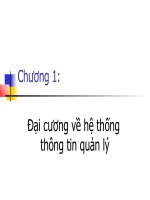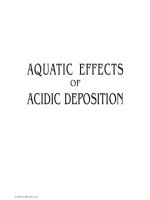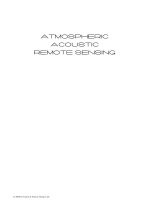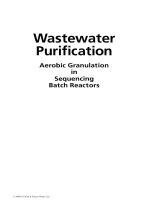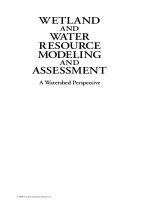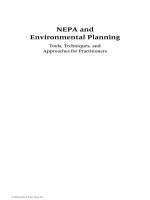Sulfate Attack on Concrete - Chapter 1 ppt
Bạn đang xem bản rút gọn của tài liệu. Xem và tải ngay bản đầy đủ của tài liệu tại đây (1.38 MB, 10 trang )
1Introduction
Portland clinker-based concrete is the most important and versatile con-
struction material used. It is an extremely complex composite material and,
considering its chemical, physical, and microstructural intricacy, it is also a
very forgiving material: in spite of severe abuse by Man and Nature, most of
the immense amounts of Portland clinker-based concrete used World over
are performing its intended functions surprisingly well.
However, this generally good performance of concrete is not a satisfactory
excuse for improper or inadequate utilization by Man of the available know-
ledge generated during the past 100 or more years. To the contrary, the cost
of repair of deteriorated concrete and its possible replacement, not speaking
about the societal cost of expensive litigations and other unnecessary
expenses, more than justifies investment into better understanding of the
nature of concrete and its performance in the environment it is used. This
book is meant to be a humble contribution to dissemination of available
information about basic aspects of concrete material science and, more
specifically, about proper treatment of both fresh and hardened concrete
to assure long-lasting durability of concrete structures in sulfate-bearing
environment.
Man abuses concrete by:
•
use of wrong or marginal concrete materials and improper mix pro-
portions;
•
inappropriate use of concrete mix compositions in structures exposed
to harsh environment and structural design unsuitable for the given
environmental exposure;
•
curing or heat treatment in conflict with chemistry and physics of concrete
microstructure development;
•
wrong placement and finishing procedures; and
•
lack of maintenance.
© 2002 Jan Skalny, Jacques Marchand and Ivan Odler
Nature causes additional challenges. Of these, the most important examples
are:
•
environmental conditions (extreme temperatures, temperature and
humidity fluctuations);
•
access to concrete of chemical species capable of reacting with concrete
components (atmospheric pollution, ground water components, industrial
waste, chlorides from sea water or de-icing salts); and
•
instability of many siliceous aggregates in the alkaline environment of
Portland cement concrete (e.g. rock components containing amorphous
silica); dolomitic limestone.
To produce concrete of highest quality and better than expected service life,
both the challenges of Nature and the inadequacies of Man have to be taken
into consideration. This can be done by:
•
improved utilization of the basic chemical and physical principles
governing the formation and destruction of cement-based materials;
•
designing concrete mixes and structures for the specific environment of
use; and
•
proper production, placement, and maintenance.
All these tasks require quality education of those involved, including the
management, research and engineering, and the actual construction
staffs.
Cement production and consumption are considered to be important
indicators of economic growth. To give the reader an appreciation of the
size of the cement business world-wide, an overview of the US and World
consumption and the top ten World producers are given in Tables 1.1 and
1.2 (PCA 2000; CEMBUREAU 2000). Consumption of concrete obviously
follows cement consumption; considering these large amounts, concrete is
clearly the most used construction material.
Sulfate attack is a generic name for a set of complex and overlapping
chemical and physical processes caused by reactions of numerous cement
components with sulfates originating from external or internal sources. For
the purpose of the following discussion, the term “cement components” will
refer to both the actual clinker minerals, such as calcium silicates and calcium
Table 1.1US and World cement consumption of Portland clinker-based
hydraulic cements (in millions of metric tons).
Year 1976 1980 1984 1988 1992 1994 1995 1996 1997 1998 1999
USA646772 81738283879399105
World 754 878 934 1,116 1,238 1,366 1,438 1,444 1,482 1,537 1,603
© 2002 Jan Skalny, Jacques Marchand and Ivan Odler
aluminates, and supplementary materials present in modern cements, such
as slag, fly ash, calcined kaolin, and microsilica.
There is some confusion in the literature and the technical community
regarding the definition of sulfate attack. For some, the term means only the
process of possible expansion caused by formation of ettringite from
external source of sulfate with the C
3
A present in the used cement. Others
do not consider damage caused by formation and recrystallization of the-
nardite to/from mirabelite to be sulfate attack, and call it physical attack or
salt crystallization. The literature, including some standards, gives several
“variations on the theme.” In our opinion, and this is supported by credible
scientific data, sulfate attack is a complex set of processes that cannot be easily
divided into physical versus chemical or calcium- versus magnesium- versus
sodium-sulfate attack. Depending on the nature of the concrete components,
the concrete processing conditions, the local macro- and micro-environments,
and the form, concentration, and nature of the sulfates in contact with the
concrete, more than one of these complicated chemical and physical phe-
nomena may occur simultaneously. This complexity is well known for years
and has been discussed, among others, by Lerch (1945), Thorvaldson (1952),
Eitel (1957), Kalousek et al. (1976), Mehta (1992, 2000), St John et al. (1998),
Taylor (1997), Skalny and Pierce (1999), Hime and Mather (1999), Mather
(2000), and many others.
The sulfate anion that reacts with cement components of concrete to
cause damage is originally present in the deteriorating system mostly in the
form of highly-soluble alkali (Na
2
SO
4
, K
2
SO
4
) or alkali earth (CaSO
4
⋅
2H
2
O,
MgSO
4
) salts or, less frequently, originates from the oxidation of pyrite in
the aggregate, from fertilizers, or from various forms of industrial waste.
Since cement and concrete are chemically and microstructurally highly
complex composites, and the ionized sulfates are often associated with
more than one or even several different cations, the chemical processes
Table 1.2 Top ten world producers of hydraulic cements (in millions of metric tons).
Includes exported clinker.
Total world production: 1,603 millions of metric tons (1999)
e = estimate
Country 1988 1990 1992 1994 1996 1997 1998 1999
e
China 210 211 308 421 491 512 536 573
Japan 7987969798968383
USA 7070707879838485
e
Russia
e
84 83 62 37 28 27 26 26
India 4554545875858799
Germany3735333631313637
Italy 3941413334353636
Korea 2934435559604849
Brazil 25 26 24 25 35 38 40 40
Thailand 12 18 22 33 40 42 30 35
© 2002 Jan Skalny, Jacques Marchand and Ivan Odler
that lead to eventual deterioration of concrete properties are highly com-
plex, interdependent, and overlapping. In addition to the above chemical
reasons, these reactions depend on the environmental exposure of the
particular concrete structure, including access of moisture, rate of water
evaporation, and temperature changes.
A few examples of damage caused by various sulfate attack mechanisms
are presented in Figures 1.1–1.4.
Deterioration of concrete by sulfates has been historically assessed in
numerous ways, neither of which gives adequate – meaning reproducible and
accurate – results under all conditions. Such assessment techniques include
visual evaluation, wear rating, loss of mass, hardness, compressive or tensile
strength, dynamic modulus of elasticity, and volume instability, and are usually
recommended by codes and standards (e.g. ASTM 1995a, 1995b; Hobbs 1998).
As the mechanisms of concrete deterioration due to sulfates are multi-
faceted, it is now clear that sulfate attack cannot be fully characterized by a
single indirect test (Clifton et al. 1999; Hooton 1999; Skalny and Pierce 1999;
Taylor 2000). Presently used tests are deemed to be indirect because they
do not take into consideration the actual cause of deterioration but only
measure the physical or mechanical consequence of the damage. For a partial
list of standards and test methods pertaining to sulfate attack in concrete see
Table 1.3.
F
igure 1.1Deposition of sulfate-bearing efflorescing material at the exposed con-
crete foundation of a residential home (Photo: J. Skalny).
© 2002 Jan Skalny, Jacques Marchand and Ivan Odler
Table 1.3 List of selected standards and test methods pertaining to sulfate attack in concrete and related material.
ASTM Designation E 150 – Specification for Portland cement
ASTM Designation C 452 – Test method for potential expansion of Portland cement mortars exposed to sulfate
ASTM Designation C 632 – Standard practice for developing accelerated tests to aid prediction of the service life of
building components and materials
ASTM Designation C 1012 – Test method for length change of hydraulic-cement mortars exposed to a sulfate solution
ASTM Designation C 1157M – Performance specification for blended hydraulic cement
ACI 201 (1998) “Guide to Durable Concrete”, ACI Manual of Concrete Practice: Part 1, ACI Farmington Hill, MI
Uniform Building Code (1997) Concrete, vol. 2, Chapter 19.
British Standard Institution, BS 5328 (1997) “Guide to specifying concrete”, Concrete – Part 1.
British Standards Institution (1997) “Cement – Part 1: Composition, specifications and conformity criteria of
common cements”, Pr ENV 197-1. Document 97/103566, Committee B/516.
British Standards Institution (1997) “Sulfate-resisting cements”, Pr ENV 197-X. BSI Document 97/103303,
Committee B/516/6.
European Standard (draft) (1998) Common Rules for Precast Concrete Products, CEN TC 229, April.
German Committee for Reinforced Concrete (1989) Recommendation on the Heat Treatment of Concrete
(in German), Berlin, September.
BRE Digest 363 (1996) Sulfate and acid attack on concrete in the ground, British Research Establishment, Garston,
Watford, UK.
Hobbs, D.W. (1998) Minimum Requirements for Durable Concrete: Carbonation- and Chloride-induced
Corrosion, Freeze-thaw Attack and Chemical Attack, British Cement Association.
Spooner, D.C. (1995) “The selection of Portland cements to British standards and on European prestandard
ENV-197-1”, The Structural Engineer
73
(20): 17–19.
© 2002 Jan Skalny, Jacques Marchand and Ivan Odler
It should be also noted that some of the tests used for assessment of
concrete durability are inadequate measures of the remaining service life.
Compressive strength is a typical example; its inadequacy in characterizing
the degree of concrete deterioration at any given time was recognized long
time ago and was recently discussed (Mehta 1997; Neville 1998; Jambor 1998).
Figure 1.2 Visible surface deterioration of concrete curbs exposed to Na- and Mg-
sulfates present in ground water. Efflorescing material identified as
sodium sulfate (Photo: J. Skalny).
© 2002 Jan Skalny, Jacques Marchand and Ivan Odler
Figure 1.3 Damaged and undamaged railroad ties (Photo courtesy of N. Thaulow).
Figure 1.4 Laboratory concrete samples attacked by sulfuric acid; paste portion
readily soluble: (a) Sample with dolomitic (acid-soluble) aggregate; and
(b) sample with silicious (insoluble) aggregate (Photographs courtesy of
C. Fourie and M. Alexander).
© 2002 Jan Skalny, Jacques Marchand and Ivan Odler
Table 1.4 Requirements for concrete exposed to sulfate-containing solutions.
Source: “Guide to Durable Concrete” (ACI 201-2R-92). Reprinted with permission by the
American Concrete Society
Notes:
1 A lower w/cm may be required for low permeability or protection against corrosion or freez-
ing and thawing
2 Includes sea water
3 Pozzolan that has been determined by test or service record to improve sulfate resistance
when used in concrete containing Type V cement
Table 1.5 Proposed requirements to protect against damage to concrete by
sulfate attack by external sources of sulfate (ACI Committee 201).
#
For detailed explanation see ACI 201 – A Guide to Durable Concrete
Sulfate
exposure
Water-soluble
sulfate (SO
4
)
in soil,
(% by weight)
Sulfate (SO
4
)
in water
(in ppm)
Cement type Maximum w/cm,
by weight (for
normal-weight
aggregate concrete)
1
Negligible 0.00–0.10 0–150 – –
Moderate
2
0.10–0.20 150–1,500 II, IP (MS),
IS (MS)
0.50
Severe 0.20–2.00 1,500–10,000 V 0.45
Very severe >2.00 >10,000 V plus
pozzolan
3
0.45
Severity of
potential
exposure
Water-soluble
sulfate
(SO
4
) in soil
(in % by mass)
Sulfate (SO
4
)
in water
(in ppm)
Maximum
water-to-
cementitious
material ratio
(by mass)
Cementitious
materials
requirements
Class 0
Exposure
0.00 to 0.10 0 to 150 No special
requirement
for sulfate
resistance
No special
requirement
for sulfate
resistance
Class 1
Exposure
More than
0.10 to less
than 0.20
More than
150 to less
than 1,500
0.50 C 150 Type II
or eqivalent
#
Class 2
Exposure
0.20 to less
than 2.0
1,500 to less
than 10,000
0.45 C 150 Type V
or equivalent
#
Class 3
Exposure
2.0 or greater 10,000 or
greater
0.40 C 150 Type V
plus pozzolan
or slag
#
Sea water
Exposure
0.45 C 150 Type II
with maximum
10% C3A or
equivalent
#
© 2002 Jan Skalny, Jacques Marchand and Ivan Odler
Sulfate attack on concrete is known for many decades, and it’s scientific
and engineering consequences have been studied by many well-established
institutions (PCA, NBS, Bureau of Reclamation, Cement and Concrete
Association) and individuals (see publications e.g. HRB 1966; Swenson
1968; ACI 1982; Marchand and Skalny 1999; Erlin 1999). However, changing
cement and concrete processing conditions, changed properties of modern
cements, as well as the availability of new experimental and computational
techniques, all call for re-evaluation of the existing knowledge on the mech-
anistic aspects of these reactions and of preventive measures. The present-
day ACI and UBC requirements for concrete exposed to sulfate containing
solutions are summarized in Table 1.4 (UBC 1997). Changes that are pres-
ently considered by ACI Committee 201 – Concrete Durability are given in
Table 1.5. The primary proposed change is introduction of 0.4 w/cm for most
severe sulfate exposure.
REFERENCES
ACI (1982) George Verbeck Symposium on Sulfate Resistance of Concrete, American
Concrete Institute, SP-77.
ASTM (1995a) ASTM Designation C 1012, “Standard test method for length
change of hydraulic cement mortar exposed to sulfate solutions”, ASTM, Phil-
adelphia.
ASTM (1995b) ASTM Designation C 452, “Standard test method for potential
expansion of Portland-cement mortars exposed to sulfate”, ASTM, Philadelphia.
CEMBUREAU (2000) Cembureau EL/AD Aug-2000.
Clifton, J.R., Frohnsdorff, G. and Ferraris, C. (1999) “Standards for evaluating the
susceptibility of cement-based materials to external sulfate attack”, in J. Marchand
and J. Skalny (eds) Materials Science of Concrete Special Issue: Sulfate Attack
Mechanisms, The American Ceramic Society, Westerville, OH, pp. 337–356.
Erlin, B. (ed.) (1999) Ettringite – The Sometimes Host of Destruction, American Concrete
Institute, SP-177, 265 pp.
Eitel, W. (1957) “Recent investigations of the system lime-alumina-calcium sulfate-
water and its importance in building research problems”, Journal of the American
Concrete Institute
28
(7): 679–697.
Hime, W.G. and Mather, B. (1999) “‘Sulfate attack,’ or is it?”, Cem. Concr. Res.
29
:
789–791.
Hobbs, D.W. (1998) Minimum Requirements for Durable Concrete, British Cement
Association, United Kingdom.
Hooton, R.D. (1999) “Are sulfate resistance standards adequate?”, in J. Marchand
and J. Skalny (eds) Materials Science of Concrete Special Issue: Sulfate Attack
Mechanisms, The American Ceramic Society, Westerville, OH, pp. 357–366.
HRB (1966) Symposium on Effects of Aggressive Fluids on Concrete, Highway
Research Record 113, HRB, Washington, D.C.
Jambor, J. (1998) “Sulfate corrosion of concrete”, unpublished manuscript summar-
izing his views on sulfate durability of concrete. (Dr Jambor passed away in May
1998.)
© 2002 Jan Skalny, Jacques Marchand and Ivan Odler
Kalousek, G.L., Porter, L.C. and Harboe, E.M. (1976) “Past, present, and potential
developments of sulfate-resisting concretes”, J. of Testing and Evaluation
4
(5)
(September): 347–354.
Lerch, W. (1945) “Effect of SO
3
content of cement on durability of concrete”, PCA
Pamphlet #0285.
Marchand, J. and Skalny, J. (eds) (1999) Materials Science of Concrete Special Volume:
Sulfate Attack Mechanisms, The American Ceramic Society, Westerville, OH, 371pp.
Mather, B. (2000) “Sulfate attack on hydraulic-cement concrete”, presented at ACI/
CANMET mtg. in Barcelona, Spain, June.
Mehta, P.K. (1992) “Sulfate attack on concrete – a critical review”, in J. Skalny (ed.)
Materials Science of Concrete, vol. III, The American Ceramic Society, Westerville,
OH, pp. 105–130.
Mehta, P.K. (1997) “Durability – critical issues for the future”, Concrete International
19
(7): 27–33.
Mehta, P.K. (2000) “Sulfate attack on concrete: separating the myth from reality”,
Concrete International
22
(8): 57–61.
Neville, A. (1998) “A ‘new’ look at high-Alumina cement,” Concrete International
20
(8): 51.
PCA (2000) US Cement Industry Fact Sheet, 16th edn, PCA Economic Research.
Skalny, J. and Pierce, J. (1999) “Sulfate attack issues”, in J. Marchand and J. Skalny
(eds) Materials Science of Concrete Special Issue: Sulfate Attack Mechanisms, The
American Ceramic Society, Westerville, OH, pp. 49–63.
St John, D.A., Poole, A.B. and Simms, I. (1998) Concrete Petrography, Arnold,
London.
Swenson, E.G. (ed.) (1968) Performance of Concrete: Resistance of Concrete to Sulfate
and Other Environments, University of Toronto Press.
Taylor, H.F.W. (1997) Cement Chemistry, 2nd edn, Thomas Telford Publishing,
London.
Taylor, H.F.W. (2000) Presentation at the annual meeting of the American Ceramic
Society, Cincinnati, OH, May.
Thorvaldson, T. (1952) “Chemical aspects of the durability of cement products”, in
Proceedings of the 3rd Int. Symposium on the Chemistry of Cement, CCA, London,
pp. 436–466.
Uniform Building Code (1997) “Concrete”, Chapter 19, in Structural Engineering
Design Provisions, vol. 2, pp. 2-97–2-183.
© 2002 Jan Skalny, Jacques Marchand and Ivan Odler
